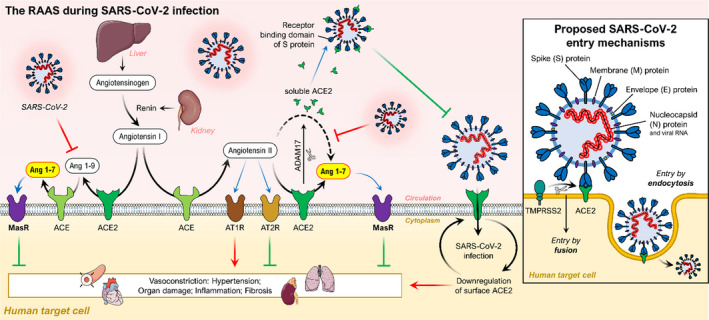FIGURE 2.

Schematic diagram of the RAAS, its protective effects on organs and its interactions with the SARS‐CoV‐2 viral entry mechanism. The protease renin cleaves angiotensinogen to generate angiotensin I. ACE plays an important role in converting angiotensin I into angiotensin II. Angiotensin II may exert some biological functions through angiotensin II receptor type 1 and 2 receptors (AT1R and AT2R), leading to potent vasoconstriction in several organs. ACE2 hydrolyses angiotensin II to the Angiotensin 1‐7, which binds the Mas receptor playing a protective role in several organs. ACE2 also hydrolyses angiotensin I to the Angiotensin 1‐9, which can be further converted to Angiotensin 1‐7 by ACE. The balance between ACE/Ang II/AT1R and ACE2/Ang 1‐7/MasR axes is a prerequisite for maintaining normal health. In addition, ADAM17 can cleave the extracellular juxta‐membrane region of ACE2. Soluble ACE2 can bind to the receptor‐binding domain of the spike protein of SARS‐CoV‐2 thus blocking further binding to ACE2 and host cell infection. (Small insert) Illustration of the viral entry of SARS‐CoV‐2. The receptor‐binding domain of the spike protein from SARS‐CoV‐2 binds to ACE2, allowing host cell entry and infection. TMPRSS2: transmembrane protease serine 2. Adapted from (Abd El‐Aziz et al. 2020)
